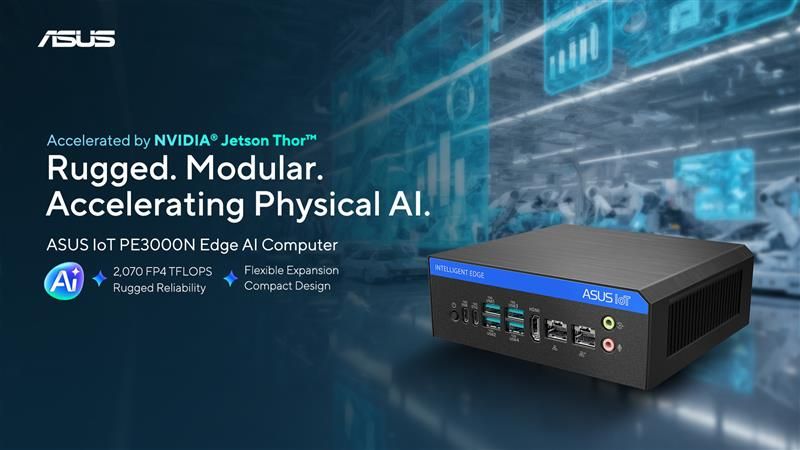ASUS IoT PE3000N: Compact Edge-AI Powerhouse with Jetson Thor
ASUS IoT has introduced the PE3000N, a compact yet powerful edge-AI platform that redefines performance for robotics and intelligent automation. Powered by the NVIDIA Jetson Thor module, it delivers remarkable AI computing performance in a space-saving chassis — offering 2,070 FP4 TFLOPS of processing power, a 14-core Arm CPU, and up to 128GB of LPDDR5X memory. Designed for industrial and commercial applications, this rugged system aims to bring next-level autonomy, precision, and adaptability to physical AI environments.
Compact Edge-AI Performance in Motion
At its core, the PE3000N is engineered to push the boundaries of compact computing. With NVIDIA Jetson Thor and its advanced Blackwell GPU architecture, the platform is optimized for high-throughput AI workloads like real-time perception, decision-making, and motion control. Despite its small footprint, the system efficiently supports complex visual language models (VLMs), large language models (LLMs), and real-time video analytics. This combination of power and size makes it ideal for robotic platforms, automated logistics, and AI-driven infrastructure where space and efficiency are paramount.
Rugged Reliability for Harsh Environments
The ASUS IoT PE3000N stands out with its MIL-STD-810H-certified design that withstands vibration, shock, and temperature extremes. It supports up to four 25GbE ports and sixteen GMSL cameras for high-bandwidth, low-latency data transmission. Combined with a wide 12–60V DC input and ignition support, it ensures uninterrupted operation in field-deployed systems such as autonomous vehicles, smart city infrastructure, and factory robotics. With an operational temperature range of -20°C to 60°C, it’s ready for real-world deployment where reliability can’t be compromised.
Flexible Design for Expansion and Integration
Built with modularity in mind, the PE3000N’s scalable chassis supports multiple configuration layers for custom I/O expansion. Interfaces like PoE, GMSL, CAN, and QSFP28 provide compatibility for diverse industrial sensors and communication protocols. An optional second stack increases vertical expansion within a 2U form factor — ideal for project-specific builds. Advanced features like TPM 2.0 security, PTP/PPS synchronization, and optional LTE/5G/GNSS connectivity make it highly adaptable for evolving AI ecosystems.
Powering Physical AI at the Edge
Beyond raw performance, PE3000N supports NVIDIA Isaac for robotics, NVIDIA Holoscan for real-time sensor fusion, and NVIDIA Blueprint for Video Search and Summarization (VSS) from the Metropolis suite — empowering users to develop and deploy complex AI workflows locally. This ensures ultra-low latency and continuous operation without depending on the cloud, making it an optimal choice for mission-critical automation and autonomous robotics. The platform’s ability to handle generative AI and video analytics directly at the edge enables a new era of responsive, intelligent systems for industrial automation.
With availability slated for late 2025, ASUS IoT positions the PE3000N as a cornerstone for future-ready AI infrastructure that merges computational power with deployment versatility. For more details, visit ASUS IoT.
| Specification | Details |
|---|---|
| Processor | NVIDIA Jetson Thor with 14-core Arm CPU |
| GPU | NVIDIA Blackwell architecture, 2,070 FP4 TFLOPS |
| Memory | Up to 128GB LPDDR5X |
| Input Voltage | 12–60V DC, ignition control |
| Networking | Up to four 25GbE ports |
| Camera Support | Up to 16 GMSL cameras |
| Expansion Options | PoE, GMSL, CAN, QSFP28, optional second stack |
| Security | TPM 2.0, PTP/PPS synchronization |
| Connectivity | Optional LTE/5G/GNSS modules |
| Operating Temperature | -20°C to 60°C |
| Certifications | MIL-STD-810H |









